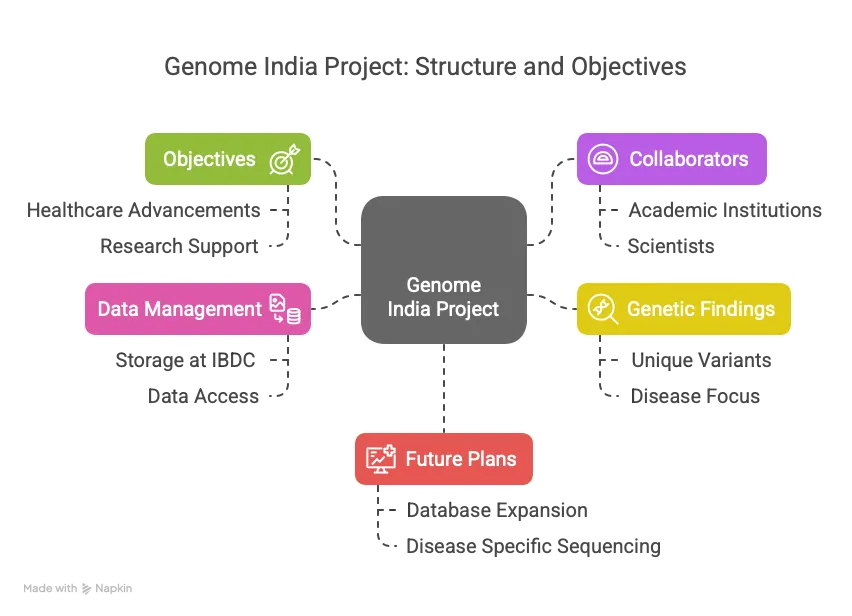UPSC
Indian Express Concise
Genome India Project: Mapping Genetic Diversity for Health and Research
Last Updated
11th April, 2025
Date Published
11th April, 2025
Share This Post With Someone


- Project Completion: The Genome India Project (GIP) completed its first phase, cataloguing whole-genome sequences of 10,000 individuals from 83 population groups across India.
- Objective: Aims to create a comprehensive genetic database to understand India’s diverse population and support advancements in healthcare and research.
- Publication: Preliminary findings published in Nature Genetics on April 11, 2025.
- Collaborators: Involves 20 academic and research institutions, with over 100 scientists, led by the Centre for Brain Research at the Indian Institute of Science, Bengaluru.
- Future Expansion: Plans to expand the database to 1 million genomes, including data from individuals with specific diseases.
- Genetic Diversity: India’s 1.4 billion population includes over 4,600 distinct groups, many endogamous, leading to unique genetic variations.
- Health Applications: Enables personalized medicine, faster diagnostics, and identification of genetic risk factors for diseases like cancer, diabetes, and neurological disorders.
- Unique Variants: Identified 135 million genetic variations, including 7 million not found in global databases, such as MYBPC3 (linked to cardiac arrest, 4.5% prevalence) and LAMB3 (linked to a lethal skin condition near Madurai, 4% prevalence).
- Disease Focus: Next phase will sequence genomes of individuals with diseases, prioritizing cancers, chronic conditions, and rare disorders specific to India.
- Data Access: Available to Indian researchers through managed access at the Indian Biological Data Centre (IBDC) in Faridabad, ensuring privacy and controlled use.
- Storage: The 8-petabyte dataset is stored at IBDC, India’s first national repository for life science data, inaugurated in 2022.
- Research Benefits: Supports studies on disease-causing mutations, population migration, and evolutionary history, enhancing public health interventions.
- Global Context: Unlike the Human Genome Project, which lacked sufficient Indian samples, GIP provides India-specific data for precise medical and genetic research.
- Methodology: Sequencing involves extracting DNA from blood, fragmenting it, tagging pieces, and reassembling the 3 billion base pairs (A, C, G, T) using DNA sequencers.
- Challenges: Initial sample collection delayed by the COVID-19 pandemic, but 10,000 genomes were sequenced in 3–4 months with improved technology.
- Leadership Quotes:
- Prof. Y Narahari (IISc) emphasized the project as a baseline for India’s genetic map, with plans for broader inclusion.
- Dr. Suchita Ninawe (DBT) highlighted cautious data sharing to protect sensitive information.
- Rajesh Gokhale (DBT Secretary) noted confidence in scaling to 1 million genomes.
- Economic Impact: Strengthens India’s bio-economy, which grew from $10 billion in 2014 to $130 billion in 2024, per Union Minister Jitendra Singh.
- Ethical Measures: Data numerically coded to avoid caste or tribe identification, ensuring privacy and preventing misuse.
Glossary:
- Genome: The complete set of DNA containing an organism’s genetic instructions, comprising 3 billion base pairs in humans.
- Whole-Genome Sequencing: The process of determining the entire DNA sequence of an individual’s genome.
- Endogamy: Marriage within a specific community, leading to distinct genetic traits in population groups.
- Genetic Variation: Differences in DNA sequences among individuals, influencing traits and disease susceptibility.
- Personalised Medicine: Tailoring medical treatment to an individual’s genetic profile for improved outcomes.
Link To The Original Article – https://indianexpress.com/article/explained/explained-sci-tech/genome-india-project-9938889/